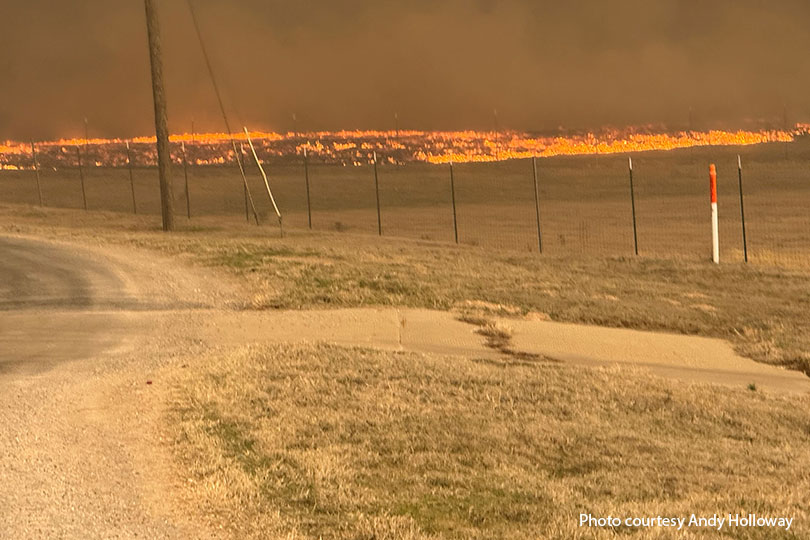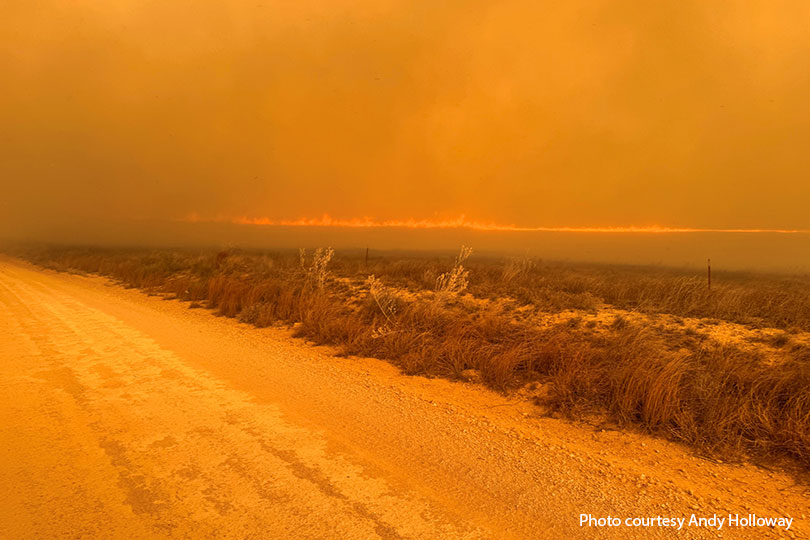By Julie Tomascik
Editor
Wildfires continue to burn across the Texas Panhandle, leaving behind a path of destruction.
As of Wednesday morning, more than 500,000 acres have burned, and several fires are still not fully contained, according to the Texas A&M Forest Service.
The Smokehouse Creek Fire, which is still burning, is the second-largest wildfire in state history, Forest Service records show.
It’s a devastating situation for Panhandle towns, families and agriculture.
The wildfires ignited Monday under warm, dry and windy conditions and have blazed a trail of devastation across the region.
For Wheeler County rancher Pat McDowell, the fire came close to his house, but it didn’t fully reach them.
“The fire was probably about 12 miles or so from our house,” he said. “We’ve had this wildfire experience a couple of times before. Our memories kicked in, and we know how fast the fire moves.”
Panhandle ranchers like McDowell are working day and night to protect their livestock and homes.
“Everybody has a plan for their operation in the back of their mind for how they’re going to handle their livestock in a fire situation,” McDowell said. “I guess it’s kind of ingrained in every rancher here.”
McDowell brought his cattle into a pasture with shorter grass, so there’s less fuel for fires.
“That pasture shouldn’t catch fire, and we penned them there,” he said. “I know everybody was trying to move their cows to the safest place, and if they did have to evacuate, they turned them out on the road to get them out of the path of the fire. I guarantee you every rancher has been working hard to protect their livestock.”
Volunteer firefighters from across the state and county crews joined farmers and ranchers to battle the blazes.
“You’re fighting Mother Nature, and it’s hard,” McDowell, who is also a former Texas Farm Bureau officer and state director, said. “It’s really tough to fight fires in this area. It’s rough ranch country. It has a lot of different canyons. Fire comes out at different points out of those canyons, and it’s just really difficult to fight.”
The fires sparked from dry conditions and more vegetation available to serve as fuel.
“We had rains last summer. So, for the first time in many years, we actually had grass going into the winter—grass, weeds, vegetation,” he said. “We had some rains in December and January, and you wouldn’t think that it could be as dry as it is. But it’s horribly dry on the surface, and there’s lots of fuel to burn.”
And it’s only February. Wildfire concerns remain high through April. With little to no wet weather forecast through the weekend, firefighters won’t have help from Mother Nature to contain the fires.
“We’re really concerned about what all can happen this year,” McDowell said.
Disaster declaration
On Tuesday, Gov. Greg Abbott issued a disaster declaration for 60 counties. View the full list of counties in Abbott’s disaster declaration.
“Hot and dry conditions caused by high temperatures and windy conditions are expected to continue in the region in the coming days,” Abbott said. “These conditions could increase the potential for these wildfires to grow larger and more dangerous.”
Fire updates
The Texas Forest Service expects the fire environment to relax beginning Wednesday through Friday.
Updates on the fire situation are available Texas A&M Forest Service’s website and on Twitter/X.



Leave A Comment